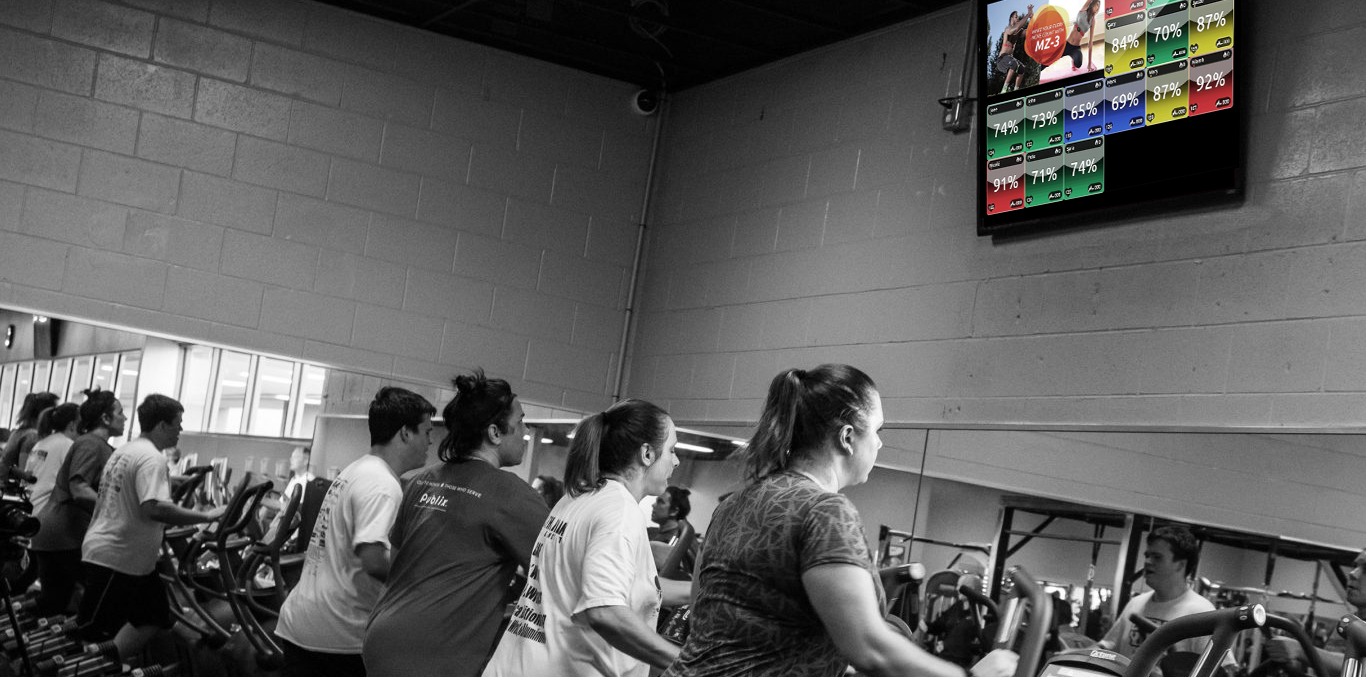Threshold Training with Myzone: What it is and isn’t
As trainers, you have probably heard of the term threshold training many times. Threshold training has many confusing and conflicting definitions within the fitness industry. In this blog, we will clarify how you can coach your clients using threshold training with the MYZONE system.

First, it is important that we start with a series of definitions to be clear on all of the terms used around threshold training.
Aerobic vs. Anaerobic Exercise
Aerobic exercise: Aerobic exercise consists of prolonged, large-muscle, dynamic movement at low to high intensity, and is associated with oxidative or aerobic energy metabolism.
Anaerobic exercise: Anaerobic exercise consists of large-muscle, dynamic movement at high intensities, and is associated with glycolytic or anaerobic energy metabolism.
Aerobic vs. Anaerobic Threshold*
Aerobic threshold*: The level of oxygen consumption at which anaerobic energy pathways start to supplement energy production.
Anaerobic threshold*: The level of oxygen consumption above which aerobic energy production is supplemented by anerobic mechanisms, causing a sustained increase in lactate and metabolic acidosis.
*Many researchers object to the use of these terms because they can be misleading. Both aerobic and anaerobic energy metabolism take place throughout various intensities of exercise (even high intensity – YELLOW and RED). At high/vigorous intensities, the anaerobic energy system does not take over completely, but rather supplements the energy supplied by the aerobic energy system. Further, researchers have been unable to show a lack of oxygen in the muscles at exercise intensities above the lactate threshold; therefore, oxygen availability may be only one of several factors that cause an increase in lactate during exercise.

Lactate Threshold and Lactic Acid vs. Lactate
Lactate threshold: The intensity of exercise at which there is an abrupt increase in blood lactate levels. Lactate threshold generally occurs at 80%+ of maximum heart rate (MHR) in trained individuals and between 60-70% MHR in untrained individuals.
Lactic Acid: An acid produced by the glycolytic energy pathway. Lactic acid can be formed anytime glycolysis (the breakdown of carbohydrate into pyruvate for energy production) takes place.
Lactate: The salt resulting from lactic acid dissociation. When lactic acid dissociates, it releases hydrogen ions (H+). The remaining compound combines with sodium ions (Na+) or potassium ions (K+) and forms the salt lactate. At higher exercise intensities, lactate accumulates in the blood, and is the substance used to measure lactate threshold. Lactate accumulation is a beneficial metabolic event, as lactate can be used to fuel working muscles.
Although they are often used interchangeably, Lactic Acid and Lactate are not the same substance; they are biochemically different. For many years, researchers and fitness professionals believed that it was the accumulation of lactate that caused muscle fatigue and the “burn” felt during intense exercise. Research has now shown that it is the accumulation of metabolic byproducts (specifically hydrogen ions) which contribute to acidosis rather than lactate.

Vigorous Intensity and Threshold Training
Vigorous intensity: Exercise intensities at or above 75% of maximum heart rate. MYZONE uses the YELLOW (80-89% MHR) and RED (90%+ MHR) zones to indicate vigorous intensity.
Threshold training: Training at or above lactate threshold for 10 minutes or longer. Lactate threshold training is associated with improved performance in endurance events.

How to use MYZONE for Threshold Training
Because you will not likely be measuring your clients’ blood lactate levels during exercise, you can use the correlates of maximum heart rate (MHR) and rate of perceived exertion (RPE) to prescribe threshold workouts for your clients.
Since we know that lactate threshold correlates with 60-70% MHR (BLUE and GREEN zones) in untrained individuals and 80%+ MHR (YELLOW and RED zones) in trained individuals, we can use the appropriate zones for our clients. Further, research suggests that lactate threshold occurs between a 7 and 8 on the RPE scale, so you can compare heart rate zone with RPE to assess whether your client is operating in their “threshold”.
Before prescribing threshold workouts for your client, make sure they first establish an aerobic base. Expand your client’s capacity by slowly increasing their exercise volume to at least 30 minutes of sustained effort in the BLUE and GREEN zones 3 to 5 days per week.
Once your client has established an aerobic base, you can play around with Threshold Training in the following ways (of course using a warm-up first and a cool-down following):
- High Intensity Steady-State Training: Have your client perform 10 to 30 minutes of steady-state exercise in the YELLOW zone. This should feel like an 8 or a 9 on the RPE scale.
- Tempo or Interval Training above Lactate Threshold: Have your client perform bouts of 1 to 5 minutes in high YELLOW or RED zones followed by recovery for 1 to 3 minutes in the low YELLOW or GREEN zones – repeat these bouts 3 to 5 times.
These workouts should feel incredibly challenging. If your client does not appear to be challenged when performing threshold workouts, make sure that their estimated maximum heart rate is accurate in the MYZONE system by logging in to your Partner Page. Work with your client to make adjustments if necessary. Try out the submaximal assessment we recommend to gauge whether or not your client’s maximum heart rate is estimated correctly.
In closing, research suggests that threshold type workouts should make up no more than 10% of your client’s total weekly exercise volume. For example, if your client is exercising for a total of 250 minutes during the week, they should perform a maximum of 25 minutes of threshold training. Therefore, you will want to encourage your client to use recovery days in between threshold workouts.
We want to know how your clients’ workouts are going! Encourage them to post their workouts and MYZONE Workout Summaries on Twitter, Facebook, and Instagram using the hashtags #MYZONE, #myzonemoves, and #effortrewarded.
For more tips on how to effectively coach and train using the MYZONE heart rate monitor, follow us during Fitness Fridays on Periscope – 8 am PST, 11 am EST.
Keep moving forward!
Share this
You May Also Like
These Related Stories

Heart Rate Recovery Assessment

Pros and Cons of High-Intensity Exercise



